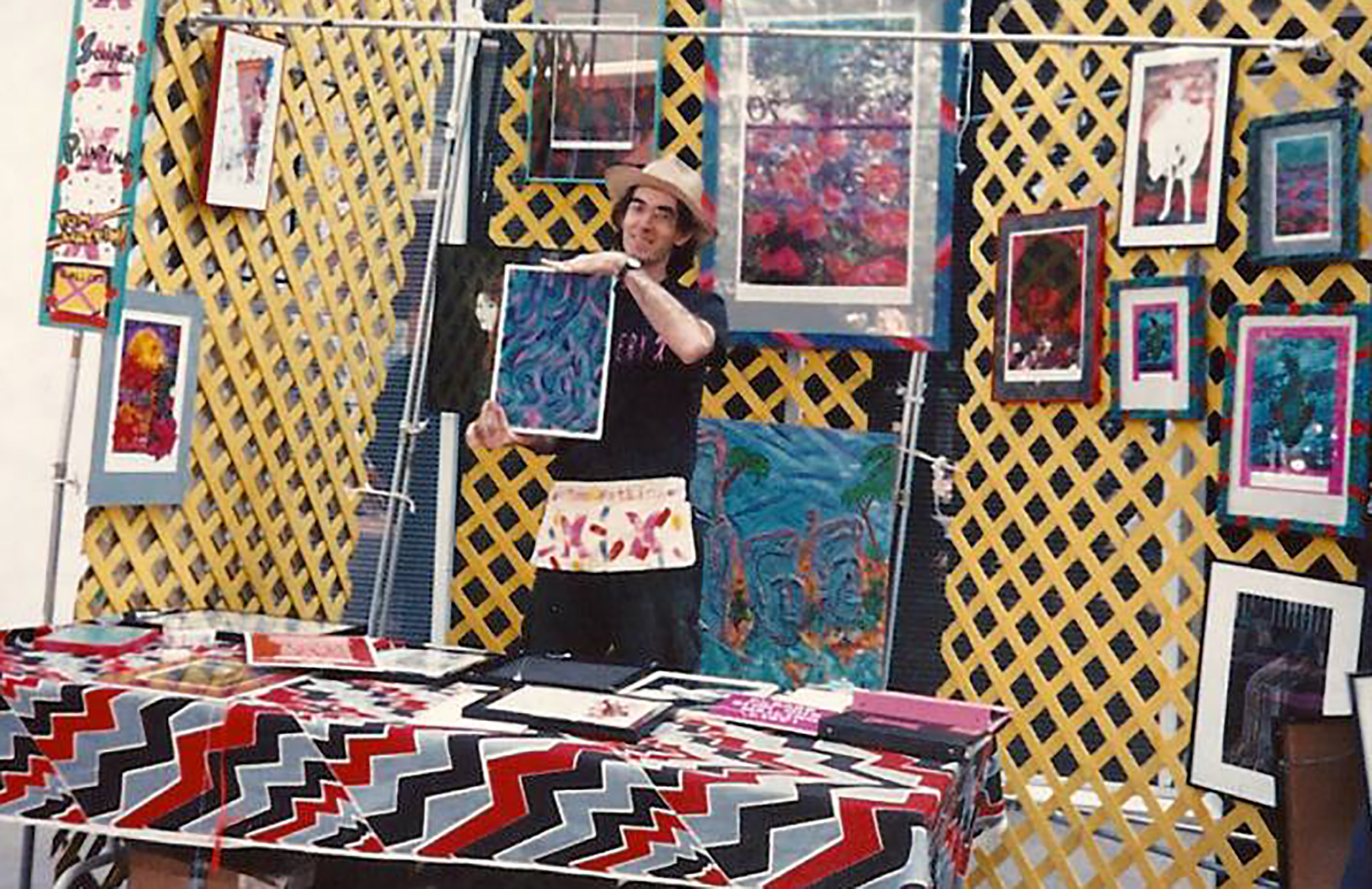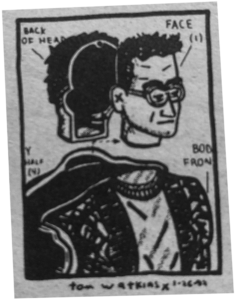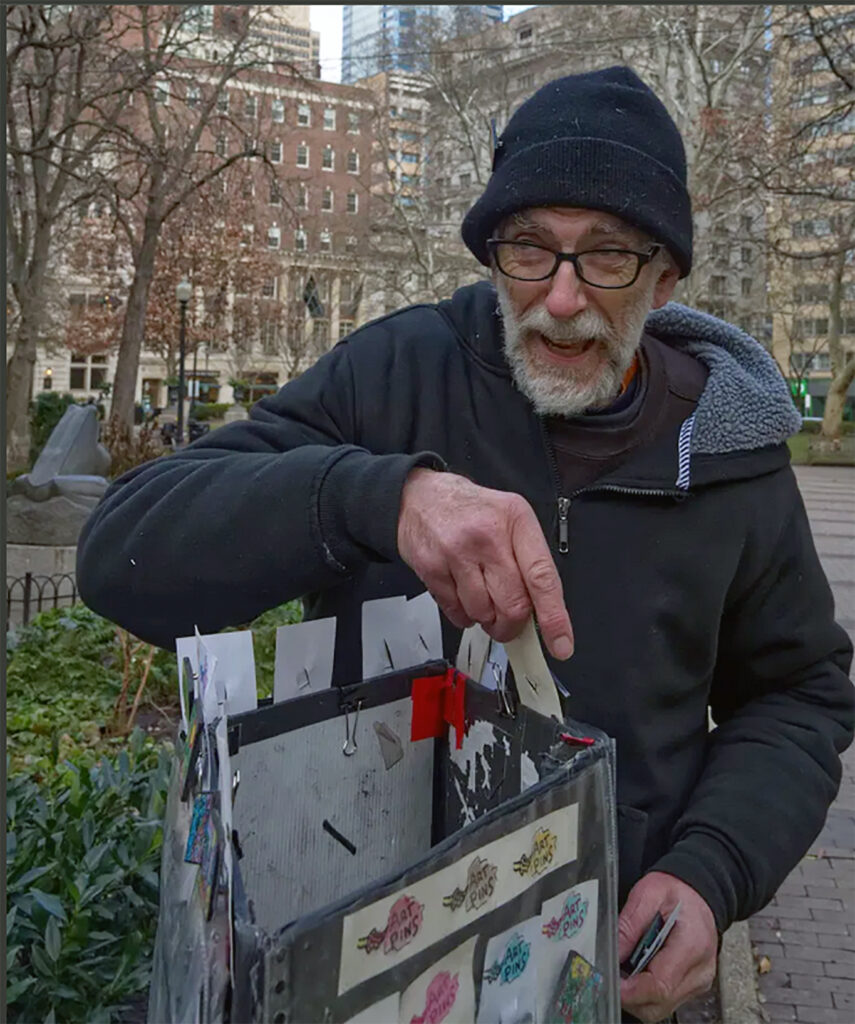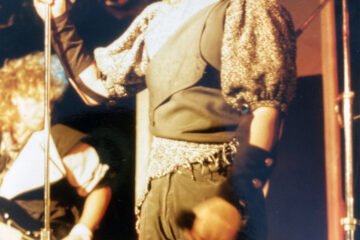Tom Watkins X (1952 – 2021)

“I’m not sure at what age you’re supposed to begin reading obituaries with daily dread. This past year, too many friends have ended up as neat little column-wide fillers between ads for flowers … and undertaking services.”
— Tom Watkins, Big Shout Magazine 1989
Tom Watkins was a multi-faceted person who was a driving force in the art, theater, and comic book scene in the early 1970s-1990s in the Wilmington, DE area. He had a hand and influence in helping launch Big Shout Magazine by providing content and artwork the first few years the publication existed. The above quote appeared in the magazine’s inaugural issue, and it was an epitaph to Tom’s friend and cohort, Rob Jones, who passed earlier in 1989. It now appears as a bit of an epitaph for Tom. According to reports from people who knew him, Tom Watkins passed at Temple Hospital in Philadelphia in mid June, 2021 from sepsis that was the result of an unattended foot infection.
Tom burst onto the art scene in the Delaware Valley with the opening of a commercial art studio called Apocalyptic Productions in 1974. His partners were Craig Dawson and Joyce Brabner, widow of Harvey Pekar (creator of the American Splendor comic book series). Tom is very inaccurately portrayed in the movie of the same name (American Splendor) by a character not named Tom who was dressed more or less as a hippy. I’m sure Tom was not happy about that. By contrast, Tom was 6′ 5″, skinny, a bit gangly and always seemed to be wearing dark glasses.
Later in the 1970s Watkins opened another commercial project with Brabner off of Market Street in Wilmington called Xanadu Comics & Collectibles. Here he openly expressed his love of comic books and the horror-movie genre.
When Brabner left for Cleveland to pursue interests and ultimately a marriage with Harvey Pekar, Tom shut down the comic book store and began focusing his energies on his artwork. He partnered with fellow artist Anne Eder and ventured into Xerography, an art form that employed the use of xeroxed images in mixed media format. The two created a range of artwork and eventually concentrated on “xerographic clothing” or “wearable art.” They were ahead of their time, but when digital technology caught up with them in the late 1980s, it brought an end to interest in xerography.
I was first introduced to Tom in late 1988, prior to launching Big Shout Magazine in March of 1989. Tom was publishing a small magazine called X-Ray and had also opened and closed another studio called Gallery X. Around this time, he began signing his artwork “Tom Watkins X.” And he was in the middle of his Xerography period.
Tom was friendly, had a sarcastic and biting wit, and seemed to be spending a good deal of time sizing me up in our initial meeting. I was blown away by his accomplishments and experiences. He had rubbed shoulders with filmmaker John Waters in the early 1970s and had already opened and closed more businesses than I could conceive of. He had dived deep into the theater world, comic book world and art world… and he was only about 10 years older than me.
He liked what my partners and I were proposing with Big Shout Magazine and he agreed to provide artwork (he did three covers for us) and some articles. Tom kept close to us in the early issues; chiding me to “cut off the finger that made you create those godawful triangle graphics in the second issue,” and giving article ideas and outside perspective as we were getting off the ground.
Early into our second year, we partnered with the City of Wilmington to create the Taste of Wilmington Food & Music Festival that drew more than 6,000 people to Market Street Mall in Wilmington for four years. Tom was the first artist we contacted to put up a booth to sell his artwork, and those were my best memories of him. I remember him happily talking to people about his T-shirts and artwork, decked out in one of his own T-shirts, fisherman’s hat and dark glasses. Those were the good days for him.

During this time, he began working on set production for two films that would become major productions: Dead Poets Society (filmed in Delaware) and 12 Monkeys (filmed in Philadelphia). Tom wrote articles for us about both of those experiences, including his interactions with the actors Robin Williams and Bruce Willis. (Click here to read his behind-the-scenes account of the Dead Poets Society movie). (Click here to read his account of the 12 Monkeys movie).
When the staff changed at the magazine in the early ’90s, I lost touch with Tom for a year or so. Then, one night he showed up at our new offices on West Street in downtown Wilmington during one of our grueling deadlines at about 2 a.m. He said very little. He just walked in, took off his coat and asked someone what needed to be pasted up.
I was too entrenched in my own deadline madness to ask what was going on with him. I could tell he had been through something possibly traumatic, and he used the intensity of the deadline work to blow off some steam. After a few hours he disappeared, and then he showed up again a few months later. One of the young college girls who was doing copy editing asked me, “Who is that guy? He kind of scares me!”
And then Tom showed up during the day and started hanging out with me periodically at the office. He confided that he had gotten married, but his wife divorced him. This was in 1994 or so, and it is at this point that I could track Tom’s long, slow decline. He told me a heart-wrenching story of how he had pleaded with his wife not to divorce him by saying to her, “You PROMISED you wouldn’t leave me … through thick and thin. In front of people!” It was about at that time that he lost interest in pursuing his artwork and commercial interests with the same fervor as before. Instead, he took to selling his spinal fluid to experimental labs in a series of spinal taps that caused him week-long headaches.
He also fell in with an unsavory crowd. He had become enamored with a dominatrix in Philly whom he had decided to follow as one of her “slaves.” I was incredulous that he was so open about telling me all of this. When I asked him why he was doing this, his response was, “When you hang out at the grocery store long enough, eventually you get free groceries!” That year for Halloween, Tom presented another cover idea to us — a very colorful mixed-media work of his dominatrix friend whipping a man who was tied up on a table. I told Tom there was no way we could put that on our cover. All of our advertisers would leave us. I asked if he could do something else, but I didn’t hear from him again.

I lost contact with Tom Watkins entirely when I moved from the Delaware Valley in 1999. This past year, several people have reached out to me asking about Tom’s whereabouts or health status, but I had no answers. A friend who is in touch with Joyce Brabner also reached out to let me know she was trying to find Tom.
This week, I’ve been in touch with a few who described Tom’s last few years as semi-homeless. In 2018, a blogger wrote a piece about Tom selling what was left of his artwork in Rittenhouse Square in Philly. I expect he was doing that for survival.
Despite how he left us, Tom Watkins will always be revered in the Wilmington art scene as an iconoclast, nonconformist and artist who brought something to audiences other than the “Brandywine Tradition.” He walked with titans, gave guidance to us mortals, but ultimately came to rest in the streets with the commoners. Godspeed, Tom Watkins X.



5 Comments
Stephen C Harvey · November 18, 2022 at 1:17 am
I knew Tom and his comic store when I lived downtown in the 70s and 80s. I still have a large negative of the Beatles at Convention Hall in 1964. Make a number of copies of it for Clem of Blondie, it ended up in some Philly restaurant and elsewhere. In 1977 I created the first fanzine on the Carpenters, Downey Soft. Tom laid out the two issues for a nominal fee. That was good because the issues didn’t sell much, but I have seen going for auction on Ebay for big bucks these days. I remember Tom promoting Rondo Hatton. I also remember Tom talking about being beaten up by two black bigots right after “Roots” appeared on TV. Downtown Wilmington was quite as bad as it would later become. Tom was a pioneer trying to bring some weirdness to stuffy Wilmington.
Joanna Hartell · May 11, 2022 at 12:08 pm
Thanks for the article and the comments about Tom Watkins. I knew him from the film business and have missed working with him. He was an interesting and talented person.
alison (gier) totten · July 17, 2021 at 9:55 am
Thanks so much for this. I too had been looking all over for Tom. I was lucky enough to do paste-up for a year or so for XRAY magazine and got the chance to sit at the feet of a genius. I had moved from Newark to NJ in 1994 and lost touch with so many folks. Thanks to George for his memories and to Sue Rich who let me know.
greggkirk · June 27, 2021 at 10:54 am
Here is a comment we received via email from George Stewart…
Thank you for filling in the gaps in Tom’s life after I saw him last at the delaware Art Museum’s celebration of the Newark and Wilmington Art Scene in the 70s.
Below is my memories of those times in Wilmington
Best,
Geo. Stewart
Producer/Host
“Crazy College” and “Scratchy Grooves”
Side Two Productions
Unconfirmed rumors are circulating that Tom Watkins has died. Here is an excerpt from my work-in-progress autobiography, “It Was Fun While It Lasted” about my days with Tom and our art collective at the Rondo Center.
After stretching out my college career past its breaking point, I found myself in Wilmington, part of a very limited and quickly apparent unsuccessful attempted at revitalizing the decaying city. Tom Watkins, Joyce Blabner, Craig Dawson and I were the foundation of an arts collective centered around the Rondo Center whose various parts included Tom Watkins’s studio and apartment, a cinematique, and a comic book store, Xanadu, run by Craig. The 4-story brick building sat on the corner or 5th and Shipley streets and use to house one of the nine newspapers that kept Wilmington’s population well informed (mostly about sports and murders) as the 18th century drifted into the 19th. The building was designed to be functional, with large windows and floors of roughly hewed wide thick planks, spotted and stained by printer’s ink and burned by the splattering of melted lead used to make type. It was on the very top floor that once housed the lino-type machines, which had been hung on iron hooks bolted to a series of mammoth beams that ran across the ceiling.
The Rondo Center itself overlooked Market Street barely perceptible through the two huge grimy windows and was dressed up with a few mismatched chairs, a couch and well-worn pillows scattered along the floor.
Tom and I booked most of the events at The Rondo Center, a casually scheduled series of programs that was eclectic in the extreme. The Rondo Center was named after an obscure 1940s character actor Rondo Hatton who suffered from acromegaly, a rare disease that progressively disfigures its victims, distending limbs and swelling facial features into a grotesque simulacrum of our Neanderthal ancestors. The once hansom actor found as sad sort of stardom as a horror actor employed by a studio pleased to be able to save a fortune in monster makeup in their rock-gut horror films.
He was the perfect mascot for Tom’s biggest undertaking, a major Happening centered around the Rondo center and Rick Jones’ studio across the street in what is now The Queen music venue. Christened The First Annual Sleaze Convention (and so far the ONLY edition of Sleaze Convention) the event brought the nascent New York Punk Scene to Wilmington. John Holstrom and Legs McNeal, the publishers of the Punk Magazine came down and Legs immediately vomited on the studio floor. Soon-to-be super star Debbie Harry also came, having just left The Stilettos for a new band, Blondie. She gave me one of the first pressings of their first 45, “Sex Offender”, which immediately became a staple on Side Two for months before Blondie’s the first album came out with the song re-recorded and retitled to the more acceptable “X Offender.” Sparing much expense, Tom booked all his guests in the fleabag Terminal Hotel, a name never more apt, given its location near the train station and the health of most of its habitués.
The centerpiece of the weekend was the Delaware premiere of John Water’s masterpiece of bad taste, “Desperate Living,” for which Tom had provided a key prop, a rubber prostatic penis that got mutilated in the movie. John was there for the opening night celebration and joined us in one of Tom’s organic buffet dinners that came with the admission.
For the Sleaze Convention, Rick Jones’ gallery displayed a broad selection of outsider art, including a wall-size collage of detritus that I had collected over the years, including a Denny’s face mask, a plastic ice cube with a fly in it, various penny toys from a time when such a thing actually priced as such, all accompanied by and endless loop to crass commercials from local broadcasting stations. “If Corns, callouses and bunions bother you” “If you have a passion for fashion…” “If you didn’t buy your suite from Krass Brothers…” If, If, If…
Later that spring Eddie “The Egg Lady” Massey, John Waters’ second most famous star, came to town for a visit. Tom somehow convinced the city fathers that such a famous personage was a natural to lead the Wilmington Easter Parade down Market Street. It even made the papers: Eddie dress regally with a basket of spring flowers promenading arm in arm in arm with a giant bunny.
The most financially successful film ever shown at the Rondo Center, was a double bill of the TAMI Show and The T.N.T Show, some of the first movies to be shot on high-def video (by Steve Allen’s crew) and then transferred to film. They are seminal documents, unseen for years, of many of the most important Top Forty acts of 1964, including the likes of Chuck Berry, Gerry & The Pacemakers, Smokey Robinson and The Miracles, Lesley Gore, The Beach Boys, James Brown and the Rolling Stones. The house was packed.
Over its 18-month existence, The Rondo Center exposed the local cognoscenti to a mixed bag of delights. I was behind the booking of a potpourri film from 1938 called “The Goldwyn Follies,” that featured many of my favorite – and very obscure – refugees from vaudeville, including the Ritz Brothers, Edgar Bergen and Charlie McCarthy. The music was by George Gershwin and proved to be his last film score before his premature death.
A patron of the arts down in Maryland somewhere lent us a tabletop half-inch video deck which I began to explore back at the Rondo Center. That first night I threaded it up and dragged the camera over to the studio’s tiny balcony that looked out on the corner of 5th & Shipley. Framing the neighborhood bar to the right and the storefront apartment next to it for no apparent reason, I began to roll tape on the quite summer’s night. After a half hour Tom became bored and so did I so when he said to turn it off, which I unfortunately did – just as a drunk staggered from the bar and made his way down the street supporting himself by leaning on the buildings. He was doing alright until he reached the apartment’s picture window that was unable to support his weight and gave way dropping a huge sheet of glass on his body as he tumbled inside. The elderly woman who lived there began a long series of defining screeches, which seemed to awake the drunk sufficiently from his stupor that he was able to rise up and toddled away. Why he had not been bifurcated horizontally by this heavy glass guillotine is a mystery for the ages that baffles me still. But they say “God protects fools, drunks and children,” though I could never figure out why the first two would get such preferential treatment.
Like most golden ages it was brief but influential. Tom’s art was years ahead of its time and migrated north thanks to Tom’s studio assistant, Julia Gordon, who had moved to New York. There she was producing with Rick Brown, a true music fanzine, one of the first to celebrate the punk scene, the long overdue reaction to the excesses of progressive rock. Called “Beat It”, it was four- to -six hand-stapled Xeroxed pages with large hand colored picture and minimal copy. Once on a stopover from a brief trip to London she came to America with the Sex Pistols debut 45, “Anarchy in the U.K.” Like a cacophonous coronavirus, it spread quickly and killed off a lot of rock star sellouts. Change was really in the air.
-30-
Raymond Harrington · June 26, 2021 at 11:57 am
Thanks